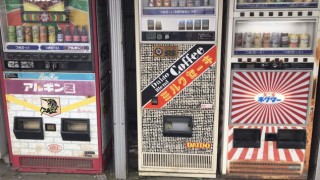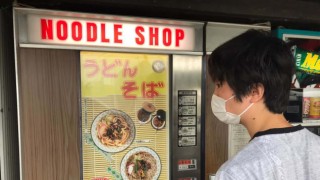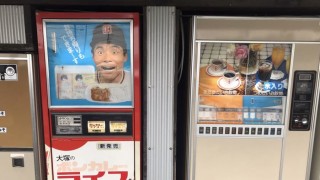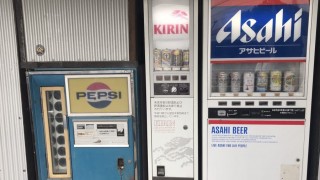Loading
Search
▼ This Small Japanese Town Is A Vintage Vending Machine Paradise
- Category:Experience
There's a reason Sagamihara, Japan, isn't in travel guides. It's a sprawling commuter city for nearby Yokohama and Tokyo; a mix of main roads, light industrial estates and quiet towns people go through rather than stop.
However, a 30-minute bus ride from Sagami-Ono station and tucked behind a main road lies Tatsuhiro Saito's used tire shop, an unexpected and remarkable destination for those looking for a taste of Japan's recent past -- dispensed from around 70 restored and working food vending machines from the Showa era (1926--1989).
Japan has long had a thing for vending machines, with more per capita than any other country. While some rare examples in parts of Tokyo dispense curios like jewelry and collectible toys, most (more than half of the four million machines currently working in Japan) dispense drinks.
Saito's collection of vintage machines -- commonly referred to in Japanese as "natsukashii," or nostalgic -- are a rare treat. The majority displayed along two covered walkways next to the dusty parking lot date from the 1970s and '80s. Sweets and snacks that were common decades ago are available and often greeted with coos of delight from visitors. If that doesn't spark a fond nostalgic feeling, there are retro toys, Kodak camera film, AA batteries and even some arcade machines.
For just 280 yen ($2), hamburgers -- classic or teriyaki flavor -- pop out of machines that date from the mid-'80s in cheery, bright yellow boxes.
Almost scalding hot cha sui ramen, just 400 yen ($3) for a serving, are served up in wobbly plastic bowls in just 25 seconds.
Other machines dispense hot Japanese-style curry roux over large rice bowls; a pleasing red digital countdown informing customers how long they have to wait before they can tuck in.
The "American popcorn" machine clonks and whirs over some jaunty tunes.
Thirsty visitors need to apply some muscle to a couple of charming but clunky vintage Coca-Cola machines to part with their classic glass bottle drinks, each 100 yen (75 cents).
Finding a following
The machines' unique designs and artwork are an attraction for many visitors as much as the food and drinks themselves.
Goro Seto, head of the Kanagawa Vespa Club, is old enough to remember some of the machines from their heyday. He recently added it as a pit stop for his group's latest ride after watching YouTube videos about Saito and his collection.
Other visitors are more into the mechanics. A local couple who are regulars to the site return regularly to see what new machine Saito adds to the collection. They claim that the Sharp-made 'Noodle Shop' ramen machine is the best because it made the dispensing hatch bigger and the food isn't scalding hot when served.
Some visitors have taken their enthusiasm even further. Yusuke Uotani has published books on nostalgic vending machines and is on the road regularly to find and report on new finds via his website.
One other well-known destination for nostalgic vending machine enthusiasts is in Marumiya in rural Gunma prefecture. It has a similar collection to Saito's, but is less accessible from Tokyo.
Behind the mystique
Saito, 50, says he didn't expect to start a business around his love of vending machines and their inner workings.
He realized that those types of machines from his childhood were becoming a rarer sight in Japan and saw it as a challenge to either restore or maintain them. He mostly bought the machines through online auctions or found through word of mouth.
Since 2016, the vending machine collection has become more time-consuming than the tire-fitting business.
Now, Saito employs almost as many people to work in the kitchens and keep the machines stocked as he does to change tires.
Spoiler alert: For those under the illusion that the machines were so high-tech they prepared and cooked all the food they served -- they don't.
While the hamburgers are made especially for Saito from the original recipe by a food supplier in Ebina (if you want to know the ingredients, you probably shouldn't be eating them), nearly all of the other meals -- toasted sandwiches, udon, curry, soba, rice and green tea salmon ochazuke -- are made in the kitchens on site.
Saito and his staff have to restock the machines daily, and sometimes multiple times per day on weekends.
Food safety laws require anyone in Japan that owns a hot food-serving vending machine to have an appropriate license and maintain sanitation standards, similar to restaurants.
It's the primary reason food vending machines used to be located close to roadside cafes and why, since the rise of Japan's ubiquitous convenience stores over the last 30 years, their numbers have dwindled.
Food vending machines in Japan reached their peak in 1985 when there were 250,000 across the country, according to the Japan Vending Systems Manufacturers Association. As of December 2021, it was down to 72,800. That number includes frozen foods like ice cream and sweets, so hot food machines are few and far between.
However, it's not all bad news.
Some machines have been enjoying something of a mini revival in the last two years, sparked in part by the pandemic's effect on restaurants' opening hours. Frozen ramen machines, for example, have been springing up outside restaurants in Tokyo over the last year.
For now, though, it seems it will be left to Saito and other mechanically minded enthusiasts to keep the flavors and memories of the Showa era alive.
- August 8, 2022
- Comment (0)
- Trackback(0)





